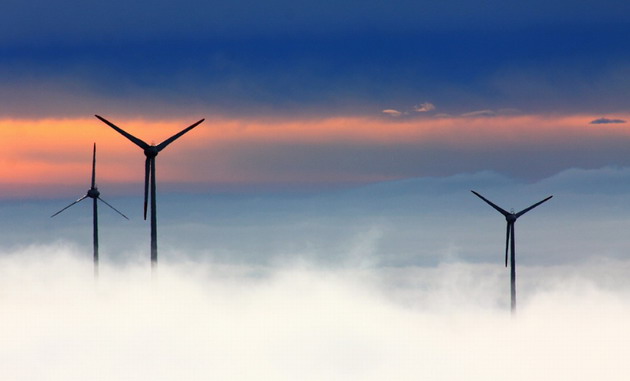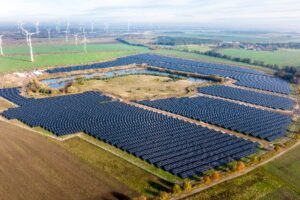Wind Power Definition

Wind energy is the renewable energy source that increased its generation capacity in the United States every year over the past decade.
In terms of generation capacity, wind power is located today on the third place among other renewables with a contribution of 22%, and is surpassed only by biomass with 50%, and hydroelectricity with 26% (source).
Being an abundant and inexhaustible source of clean energy, wind power has a great potential to become a main source of energy in the country where along with the other sources of renewable energy like hydro, biomass, geothermal, solar, etc. will slowly replace the energy produced from fossil fuels.
Wind Power Definition
Wind power or wind energy is a renewable resource that uses the kinetic energy of the wind to spin a turbine that will produce electricity by rotating the shaft of a generator.
The power of the wind is also used by wind mills for milling grain and pumping water.
For energy generation, we are using today, large horizontal axis wind turbines installed on land or offshore, and vertical axis wind turbines (these are friendlier to the environment) for residential use.
How Does Wind Power Work?
Wind is the movement of the air produced by the differences in atmospheric pressure and the speed of the wind will vary based on the geography and topography of the place and also the season.
Open areas with no obstacles such as tall trees, buildings, landforms, etc., have a bigger chance to provide a strong and steady supply of wind, which can be harvested for clean energy generation.
For large scale power generation, we are using today very tall wind turbines (horizontal axis) installed onshore, and also offshore.
For residential generation (home use) we are using small horizontal axis wind turbines and vertical axis wind turbines.
How Does A Horizontal Axis Wind Turbine (HAWT) Work?
The power of the wind has helped mankind to do different tasks since ancient times, but today, we are using large horizontal axis wind turbines installed on the land and offshore to produce clean electricity for the grid.
Today’s wind turbines are capable of turning a great amount of energy in the wind into electricity due to the fact that the blades of the turbine have evolved.
The blades used today by a horizontal axis wind turbine rely on a simple airfoil technology that makes the wind turbine to turn, which means that a lift force is produced when the wind moves over an airfoil.
The wind moves over the numerous airfoils of the blades, and this is how the rotation of the wind turbine is achieved.
Horizontal-axis Wind Turbines Are Much Larger
The moving blade of the turbine experiences the wind relatively, and this is the reason why the relative wind velocity (VR) equals the difference between the velocity of the wind (Vwind) and the velocity of the blade (Vblade).
VR=Vwind-Vblade
This is the reason why the wind turbine blade is positioned in a tilted manner in order to be aligned with the relative wind speed (VR).
As the blade velocity increases to the tip, the relative wind speed becomes more inclined towards the tip, and this how a continuous twist is given the blade from the root to tip.
The wind turbine spins at low speed, which is not enough for energy generation, so before being connected to the generator, the speed is increased in a gearbox.
Gearbox
The gearbox uses a planetary gear set arrangement to achieve the high speed ratio requested for energy generation (the rotation speed increases about 90 times).
A brake sits in the nacelle and is used to stop the wind turbine in case of excessive windy conditions.
For maximum efficiency, the wind turbine should face the wind all the time, but because the direction of the wind can change in any moment, a velocity sensor located on the top of the nacelle measures wind speed and direction.
When a deviation in the wind direction is detected, the sensor sends a signal to an electronic controller, which sends a signal to the yawing mechanism to correct the error (will turn the nacelle to make the turbine face the wind).
This is how a horizontal axis wind turbine is always aligned with the wind direction.
When the sensor detects a change of the wind speed, the relative velocity of the wind (VR) also changes, and a blade tilting mechanism tilts the blades to guarantee a proper alignment of the blades with the relative velocity.
Thus the blades will always be at the optimal angle of attack with the relative wind flow.
The electricity produced by the wind turbine is consequently transferred through cables towards the base, where a step-up transformer is located.
The theoretical maximum efficiency achieved by a wind turbine is known as Betz’s limit, and tells that no wind turbine in the world can ever cross the efficiency limit of 59.3 percent.
How Does A Vertical Axis Wind Turbine (VAWT) Work?
Vertical axis wind turbines are different from HAWT’s because their rotor is oriented vertically.
VAWT’s have been around from a while, earlier versions like the Savonius, Darrieus and the Gyro-Mill type, had some issues due to the forces applied to the blades on each revolution, and this is the reason why newer designs use a helical blade pattern to alleviate some of those problems.
Exactly like HAWT’s, VAWT’s generate power the same way, when air passes over the airfoils (turbine blades), the rotation of the blades spins the shaft of a generator and produces electricity.
Advantages of Vertical Axis Wind Turbines over Horizontal Axis Wind Turbines
- 1. VAWT’s have the generator located at the base of the turbine for easier maintenance (some VAWT’s don’t need a gearbox to generate power).
- 2. VAWT’s don’t require a yawn mechanism because they face the wind all the time (at least with one blade that start the rotation movement right away).
- 3. VAWT’s work fine in turbulent and gusty winds.
- 4. VAWT’s can be used where HAWT’s can’t be used like rooftops and residential areas because they are more quiet.
- 5. VAWT’s can be grouped much closer together, which means that they can produce way more power per square meter or square mile than horizontal axis wind turbine farms.
Disadvantages of Vertical Axis Wind Turbines
- 1. VAWT’s suffer due to a wide variation of angle of attack.
- 2. VAWT’s are less reliable and less efficient compared to HAWT’s because only a couple of blades facing the wind are producing the torque required to rotate the turbine.
- 3. Some VAWT designs suffer from self-starting problems in low wind speeds.
Challenges of Wind Power
Being produced by the kinetic energy of the wind, this source of renewable energy is intermittent, which means that it produces electricity only when the wind blows with a speed that is fast enough to start the rotation of the turbine, and not so fast to destroy the turbine.
This is the reason why wind power is often paired with another source of energyh2 (usually fossil fuels – natural gas) to provide a continuous supply of electricity to the grid.
Horizontal axis wind turbines (HAWTs) are known for the noise produced by the rotating blades (this is the reason why they need to installed far away from human settlements.
HAWTs are also known as bird and bat killers, which means that even if they produce energy without releasing greenhouse gas emissions into the atmosphere, by killing those poor animals they are also destroying wild life.
Final conclusion
Wind power will truly become an energy source of the future only when the turbines used to turn the wind into electricity will work without destroying wild life, and without producing noise pollution.






